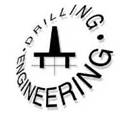 Optimising the hydraulics of the circulating system
Optimising the hydraulics of the circulating system
5.1 Designing for Optimum Hydraulics
The two major aims of an optimum hydraulics programme are:
• To clean the hole effectively
• To make best use of power available to drill the hole.
To achieve the first aim the hydraulics must be designed so that the annular velocity never falls below a pre-determined minimum for lifting cuttings (say 130 ft/min). The second aim is attainable by ensuring that the optimum pressure drop occurs across the bit. Since this pressure drop will depend on circulation rate some careful designing is required to satisfy both objectives.
There are two different approaches to optimum hydraulics design:
a. Maximise the Hydraulic Horsepower at the Bit
This assumes that the best method of cleaning the hole is to concentrate as much fluid energy as possible at the bit.
b. Maximise the Hydraulic Impact at the Bit
This assumes that the most effective method is to maximise the force with which the fluid hits the bottom of the hole.
The more popular approach is to maximise the hydraulic horsepower at the bit and this will be dealt with in more detail.
a. Maximising Hydraulic Horsepower
The source of all hydraulic power is the pump input from the mudpumps. The hydraulic horsepower at the pump is therefore given by:
HHPt = input HP x Em
Equation 36 Hydraulic Horsepower at the Bit
|
|
where,
Em = mechanical efficiency
The hydraulic horsepower at the bit (HHPb) can be written as:
HHPb = HHPt — HHPs
where,
HHPt = total hydraulic horsepower available from the pump
HHPs = hydraulic horsepower expended in the circulation system (excluding the
bit) s
HHPt can be related to the discharge pressure and flow rate:
HHP
1 1714
Equation 37 Total Hydraulic Horsepower
where,
Pt = total discharge pressure (psi) Q = flow rate (gpm)
similarly:
PQ
HHP = -s^-
s 1714
Equation 38 Sacraficial Hydraulic Horsepower
where,
Ps = pressure drop in system (excluding the bit) Therefore Equation 36 can be rewritten as:
PtQ PQ
HHP, = — ——- —
b 1714 1714
Equation 39 Hydraulic Horsepower at the Bit
An empirical relationship between P and Q in turbulent flow gives:
Ps = kQn
Equation 40 Empirical Equation for Pressure Losses in the SystemPs = kQn
where,
k and n = constants for the system (includes wellbore geometry, mud properties, etc) Substituting for Ps in equation 39 yields:
PtQ KQnQ
HHP = t______
TOC o "1-5" h z b 1714 1714
PtQ KQ(n+1)
HHPb= ———— —
b 1714 1714
Equation 41 Pressure Loss Across Bit When Horsepower at the Bit is Maximum or
Differentiating with respect to Q to find maximum HHP
dHHPb_ Pt (n+1)KQn
dQ _ 1714 1714
The maxima and minima will occur when the above equals zero:
Pt = (n+1)kQn Pt = (n+1)Ps
or
P — 1 P
|
n (n +1) P1 |
s (n +1) 1
It is generally found in circulation rate tests that n is approximately equal to 1.85 and therefore for maximum HHPb the optimum pressure drop at the bit (Pb) should be 65% of the total discharge pressure at the pump. This condition must be built into the hydraulics programme to achieve maximum efficiency.
Note that Pt remains constant throughout.
b. Maximising Hydraulic Impact
The purpose of the jet nozzles is to improve the cleaning action of the drilling fluid at the bottom of the hole. Before jet bits were introduced, rock chips were not removed efficiently and much of the bit life was consumed regrinding the rock fragments. While the cleaning action of the jet is not well understood, several investigators have concluded that the cleaning action is maximized if the total hydraulic impact force is jetted against the hole bottom. If it is assumed that the jet stream impacts the bottom of the hole in the manner shown in Figure 15 all of the fluid momentum is transferred to the hole bottom. Since the fluid is travelling at a vertical velocity
|
|
vn before striking the hole bottom and is travelling at zero vertical velocity after striking the hole bottom, the time rate of change of momentum (in field units) is given by:
Fi = 0.000516 x MW x Qx Vn
Equation 42 Impact force of fluid ejected from nozzle
where,
MW = mud weight (ppg)
Q = flow rate (gpm) vn = nozzle velocity (ft/s)
Maximising the impact force can be achieved by ensuring that Pb = 0.49 Pt or Ps = 0.51Pt

